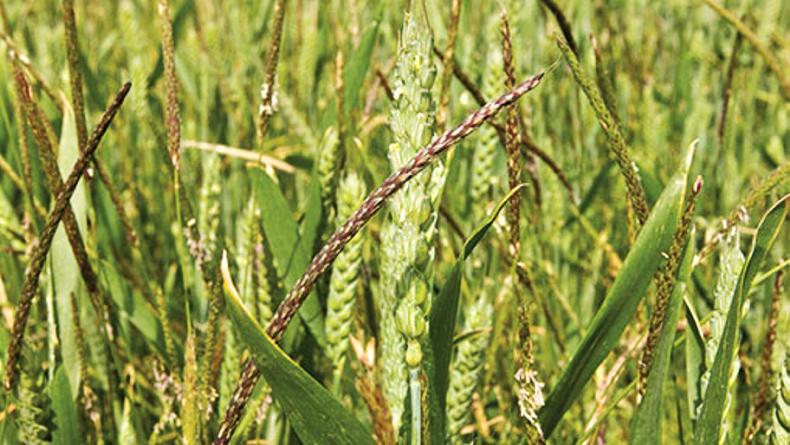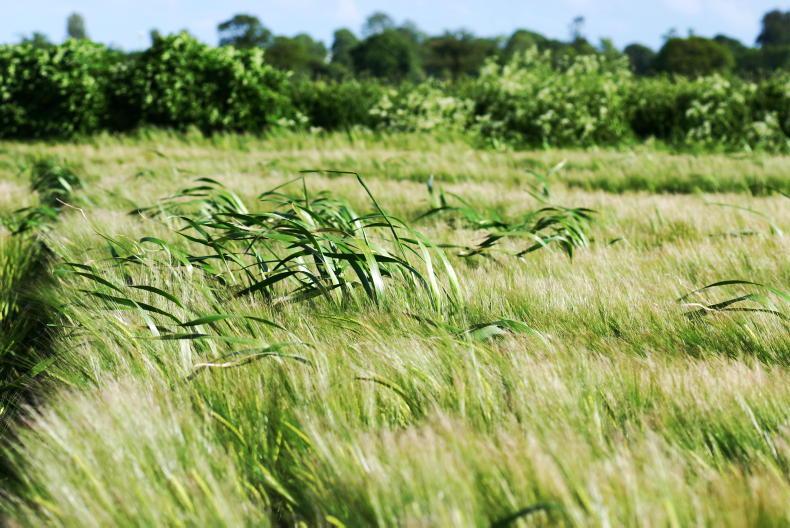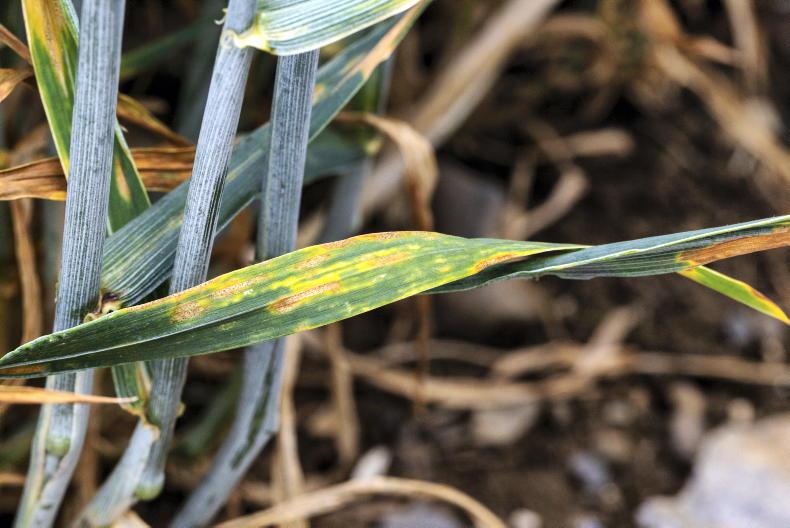The incidence and spread of difficult-to-control grass weeds, especially sterile brome, wild oats, canary grass and blackgrass, is increasing on most tillage farms. Repeated use of the main herbicide actives against these grasses has allowed resistance to develop.
Resistant weed populations may by-pass the herbicide action by two mechanisms: target-site resistance, where cellular pathways prevent the herbicide from binding effectively to its site of action; and non-target site resistance, where more complex cellular changes allow the weed to detoxify the herbicides and allow the plant to grow normally.
Herbicide resistance is further exacerbated by the narrow range of herbicides available, forcing growers to repeatedly use the same active ingredients.
One key to managing grass weeds and to minimising the selection pressure for resistance is to utilise non-herbicide control measures or integrated weed management (IWM) practices.
Correct weed identification, coupled with an understanding of their agro-ecological traits, is of paramount importance in devising IWM programmes
IWM combines non-herbicide or cultural techniques with herbicide use when needed. IWM also targets weed seed bank reduction and prevents weed movement to different areas.
It encourages farmers to keep fields free of specific weeds, reduce the pressure on herbicides and prevent seed return.
Correct weed identification, coupled with an understanding of their agro-ecological traits, is of paramount importance in devising IWM programmes.
Identification and agro-ecology of grass weeds
Sterile brome (very common on all farms): around 90 % of brome germinates from August to December; it flowers from May to July and sheds seeds from July to August. It requires vernalisation to produce seeds and readily germinate in the dark. Seeds have a short dormancy, but as each plant can produce over 200 seeds, annual seed decline is about 85% to 90% (seeds have poor persistence in soil). Seed emergence is reduced by increasing seed burial depth (> 10cm).Blackgrass (increasing problem): about 80 % of blackgrass germination occurs from August to October and it sets seeds from May to August. Seed shedding is from the middle of June in winter wheat, with most seeds shed prior to harvest. Blackgrass is mainly cross-pollinated by the wind, and light induces seed germination. The weed can produce 400 to 600 seeds per plant, but this can be much higher where a plant has ample space. While seed decline when buried is relatively rapid (70% to 80% per year), the soil seed bank will increase rapidly if it is not controlled. Deeper burial (>5cm) reduces seed emergence of freshly shed seeds. Wild oats (common across Ireland) and canary grass (becoming more widespread): wild oats and canary grass both emerge at the same time as spring cereals and can outcompete the cereal at an early growth stage with a high density of emerging plants. Both spring-germinating weeds have the ability to survive dormant in the soil for a substantial period of time and thus are unaffected by seed burial depth. They flower from June to October and light promotes germination. Most seeds originate from the top 10cm of soil, but wild oats can emerge from a depth of 15cm. Practices contributing to
increased grass weed pressure
The following practices will increase the grass weed pressure on your farm: repetitive cereal cropping; earlier sowing of autumn-sown cereal crops; excessive reliance solely on herbicides; mechanical spread of weed seeds from contaminated manures, seed source, combines and by movement of straw bales; lack of field margin or headland conservation to prevent these areas becoming potential sources of weed infestation.
IWM programmes
Effective IWM practices include the use of crop rotation, stale seedbeds, crop establishment techniques, headland/margin management, hand rogueing, machine hygiene, seed source, sowing date, seed rate, variety choice and use of herbicides.

Sterile brome remains a challenging grassweed in tillage rotations.
In the future, IWM practices will have to be adopted by Irish farmers to minimise resistance development to protect existing chemistry, as very few new herbicides are expected in the near future.
The combination of these practices against the various problematic weeds will be evaluated and developed on focus farms in the Enable Conservation Tillage grass weed control project over the next few years.
Read more
Crops & Spreaders event offers something for everyone
The incidence and spread of difficult-to-control grass weeds, especially sterile brome, wild oats, canary grass and blackgrass, is increasing on most tillage farms. Repeated use of the main herbicide actives against these grasses has allowed resistance to develop.
Resistant weed populations may by-pass the herbicide action by two mechanisms: target-site resistance, where cellular pathways prevent the herbicide from binding effectively to its site of action; and non-target site resistance, where more complex cellular changes allow the weed to detoxify the herbicides and allow the plant to grow normally.
Herbicide resistance is further exacerbated by the narrow range of herbicides available, forcing growers to repeatedly use the same active ingredients.
One key to managing grass weeds and to minimising the selection pressure for resistance is to utilise non-herbicide control measures or integrated weed management (IWM) practices.
Correct weed identification, coupled with an understanding of their agro-ecological traits, is of paramount importance in devising IWM programmes
IWM combines non-herbicide or cultural techniques with herbicide use when needed. IWM also targets weed seed bank reduction and prevents weed movement to different areas.
It encourages farmers to keep fields free of specific weeds, reduce the pressure on herbicides and prevent seed return.
Correct weed identification, coupled with an understanding of their agro-ecological traits, is of paramount importance in devising IWM programmes.
Identification and agro-ecology of grass weeds
Sterile brome (very common on all farms): around 90 % of brome germinates from August to December; it flowers from May to July and sheds seeds from July to August. It requires vernalisation to produce seeds and readily germinate in the dark. Seeds have a short dormancy, but as each plant can produce over 200 seeds, annual seed decline is about 85% to 90% (seeds have poor persistence in soil). Seed emergence is reduced by increasing seed burial depth (> 10cm).Blackgrass (increasing problem): about 80 % of blackgrass germination occurs from August to October and it sets seeds from May to August. Seed shedding is from the middle of June in winter wheat, with most seeds shed prior to harvest. Blackgrass is mainly cross-pollinated by the wind, and light induces seed germination. The weed can produce 400 to 600 seeds per plant, but this can be much higher where a plant has ample space. While seed decline when buried is relatively rapid (70% to 80% per year), the soil seed bank will increase rapidly if it is not controlled. Deeper burial (>5cm) reduces seed emergence of freshly shed seeds. Wild oats (common across Ireland) and canary grass (becoming more widespread): wild oats and canary grass both emerge at the same time as spring cereals and can outcompete the cereal at an early growth stage with a high density of emerging plants. Both spring-germinating weeds have the ability to survive dormant in the soil for a substantial period of time and thus are unaffected by seed burial depth. They flower from June to October and light promotes germination. Most seeds originate from the top 10cm of soil, but wild oats can emerge from a depth of 15cm. Practices contributing to
increased grass weed pressure
The following practices will increase the grass weed pressure on your farm: repetitive cereal cropping; earlier sowing of autumn-sown cereal crops; excessive reliance solely on herbicides; mechanical spread of weed seeds from contaminated manures, seed source, combines and by movement of straw bales; lack of field margin or headland conservation to prevent these areas becoming potential sources of weed infestation.
IWM programmes
Effective IWM practices include the use of crop rotation, stale seedbeds, crop establishment techniques, headland/margin management, hand rogueing, machine hygiene, seed source, sowing date, seed rate, variety choice and use of herbicides.

Sterile brome remains a challenging grassweed in tillage rotations.
In the future, IWM practices will have to be adopted by Irish farmers to minimise resistance development to protect existing chemistry, as very few new herbicides are expected in the near future.
The combination of these practices against the various problematic weeds will be evaluated and developed on focus farms in the Enable Conservation Tillage grass weed control project over the next few years.
Read more
Crops & Spreaders event offers something for everyone












SHARING OPTIONS